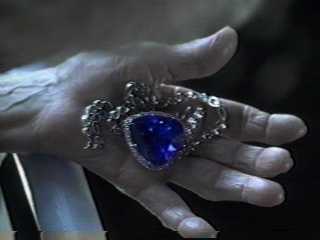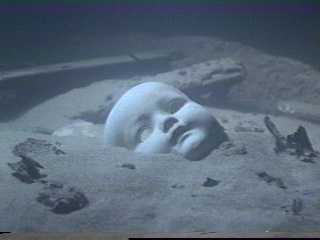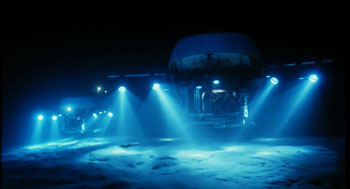James Cameron has mentioned that people at the turn of the century were acutely innocent in their belief that the world was just going to keep getting better. The Titanic is a symbol of such unbridled optimism. It is a massive, "unsinkable" object of man's creation. In many ways this mindset is best represented in the character of Cal. At the dinner scene, in contrast to Jack's comment about winning a lucky hand in poker, Cal confidently pipes in with: "A real man makes his own luck." Cal believes that "God himself" can not sink the Titanic. The smoking room is a place where he and others go to, according to Rose, "congratulate each other on being masters of the universe." They had good reason to do so. Nothing in history had so far indicated that things were any different.
Such naiveté is represented quite well in Mr. Ismay's and Mr. Andrews' feelings about the ship. Ismay proudly proclaims that the ship "is the largest moving object ever made by the hand of man in all history." To which Mr. Andrews adds: "a steamer so grand in scale, and so luxurious in its appointments, that its supremacy would never be challenged." Ismay concludes that he chose the name "Titanic" "to convey sheer size. And size means stability, luxury and safety." This prompts Rose to make her humorous and quite rebellious remark regarding Dr. Freud's thinking on the male fascination with size.
Rose represents more than just a rebellious nature in the face of such unmitigated naiveté and outright arrogance. Cameron uses the character to create a thread of irrational thinking and behavior that is interwoven in the fabric of this innocent world. Rose's Freud remark is not just a funny line, it is a critique of the male dominated world of eternal "progress" from a perspective that seems "deviant" (to borrow from Nietzsche) compared with the mythology of logic and precision that has fabricated the Titanic.
This comparatively irrational form of life is made manifest in several scenes of the film. There's the obviously "crazy" behavior of Rose as she attempts to jump from the Titanic when it is not sinking and reboard the ship from a lifeboat as it is going under. Jack points out that it is "crazy" that they plan to get off the ship as a couple. It makes no sense when you consider their differing cultural backgrounds. Things just don't work out this way.
As Jack and Fabrizio board the ship Jack begins to wave good-bye to everyone on the dock. Fabrizio is puzzled and asks if Jack knows someone. Jack replies: "Of course not. That's not the point. Good-bye! Good-bye!! I'll miss you!!" His companion soon joins in. The gesture takes on its own meaning, without relevance to anything specific. As Rose unpacks her recently acquired Picasso, Cal observes that it was such a waste of money. She justifies the purchase with "You're wrong. They're fascinating. Like in a dream... there's truth with no logic." When Jack and Rose dance at the steerage party Rose objects that she doesn't know the steps. Jack encourages her with "Don't think, just go with it."
Rose happens upon a steward in the midst of her frantic efforts to save Jack from drowning in chains. The steward tries to take her to safety, but she won't have any of it. She pulls and tugs away at him. "There's no need to panic," the steward states. "You're going the wrong way," Rose cries. The wrong way. It's a time when the way to safety is not the way to go. You must go back toward the danger. He continues to pull her along. She finally jabs him with a solid fist. He leaves her. At last she sees a way. The ax in the fire casing. She returns without hesitation to where the water level is rising ever higher.
Absurdity manifests itself in two ways throughout "Titanic". First, there are the absurd actions of the characters themselves within the film. Then there's the experience of the absurd as it presents itself within their lifeworlds. Mr. Ismay takes center stage here. As the damage to the ship is being discussed he asks (oblivious to reality),"When can we get underway again, dammit!?" When Mr. Andrews makes clear the irreversible nature of things, Ismay goes wild-eyed and gasps "But this ship can't sink!" Andrews' conclusion insults the reality in which Ismay lives.
We've already highlighted Mr. Andrews' walk through the festive crowd as lifeboats are being readied. The absurd crops up in other ways throughout the film. After numerous brushes with death, Rose and Jack burst through a wall to finally make it to a hallway of safety. A steward who happens to be standing there admonishes them. "You'll have to pay for that, you know! That's White Star Line property!" Much earlier, as Rose and Jack walk about the top deck, Jack abruptly asks her if she loves Cal. Rose is shocked by his forwardness. "This is absurd!" she gasps. So it is by the established standards of decorum.
As Rose ponders the sea beneath her feet in the suicide scene, Jack arrives. She tells him not to come any closer or she'll jump. After a moment, Jack abruptly interjects, "No you won't." This is absurd to Rose and exasperates her. "Don't presume to tell me what I will and will not do!" Then she tells him to "go away! You're distracting me!" From what? Jumping to her death?!
Rose tells Jack not to be "absurd" when he proclaims that he will have to jump in the water after her. "The fall alone would kill you," she adds, given the fact that she is contemplating making that same fall herself. Matters twist around upon themselves, the absurd within the absurd, when Jack continues to talk about how cold the water is and about ice fishing in Wisconsin. Rose becomes frustrated and calls him "crazy." Jack is quick to point out, in his own way, how absurd it is for Rose to say that. After all, she's the one hanging over the railing.
Thinking is inappropriate, gestures don't mean what you think, actions don't make sense, truth is possible without a shred of logic, characters act absurdly and experience the absurd within their lifeworlds. This is the reality Cameron creates within the larger world of naive optimism and arrogance.
 All this action, featuring Kate Winslet almost exclusively, is splendidly performed and directed. It is, perhaps, the most underrated sequence of the film and is not just irrational but absurd.
All this action, featuring Kate Winslet almost exclusively, is splendidly performed and directed. It is, perhaps, the most underrated sequence of the film and is not just irrational but absurd.
Cal says it represents "royalty." Rose calls it "a dreadful, heavy thing." Brock has thought about it and little else for three years. But no one can quite capture this elusive necklace with the large, dark diamond. It is the marriage of mystery and grandeur, of desire and of pain (Rose's caged pain, Brock's longing pain, Cal's ungraspable pain, and pain of Jack's body, freezing to death).
After Rose's would-be suicide is explained away as an attempt by her to see the propellers of the ship, Colonel Gracie chimes in with the simple "fact" that "Women and machinery do not mix." This defines the dichotomy between the irrational and the mechanical mind. But, that is only man's take on the feminine at the turn of the century. Cameron tells us in several private moments how women view themselves, which completes the reality of their situation during this time in our history.
When Rose remarks that it is so "unfair" that she has to go through with a marriage she doesn't desire just to keep herself and her mother out of poverty, Ruth crisply explains: "Of course it isn't, we're women. Our choices are never easy." Rose later leaves a note for Cal in the safe along with Jack's nude rendering of herself. It reads: "Darling, now you can keep us both locked in your safe," further connecting the Heart of the Ocean with feminine Being (literally). Rose felt possessed (safely locked up) by her world with Cal and the rest. In a way, Jack's drawing, with all its delicacy and sensuousness, puts on paper the essential nature of women from a male dominated viewpoint. Women are objects of beauty and grace, but little more, just as the diamond is an object of these same qualities for men to hold and admire.
But, in the end, it cannot be held or even really touched. When Brock's team recovers the rendering it can only be observed, not handled, for fear of its disintegration in the hands attempting to hold it. Even the old Rose must view it submerged in the solution of a surveyor's dish. It is see and known, but beyond reach despite being right THERE before our very eyes.
"A woman's heart is a deep ocean of secrets," we hear from the old Rose as she nears the end of her tale. Cameron intends for us to connect her experiences as a woman with the fantastic jewel that helps to form the film's conclusion. But, she continues, Jack Dawson saved her in every way a person could be saved. Physically and spiritually. Rose went on to live a rich life carrying the diamond in secret all the while. The diamond is a material object, but to Rose it is much more. It is a spiritual entity, the home of a brief passionate experience from her youth of which she promised Jack she would "never let go." That's why it could never be sold. She drops the diamond in the ocean and we watch it swirl out of sight just as we saw Jack's body fall slowly into the blackness. The secret preserved. The mystery and darkness, perpetual. The Heart of the Ocean is a Jungian type symbol. It represents the purely feminine qualities of human psychology. To fully understand its nature, why Rose keeps the diamond in secret all those years, why she doesn't (logically) sell it and become instantly rich, and why she returns it to the depths of the ocean unbeknownst to anyone, you have to understand what Cameron tells us about women in the film.
The Heart of the Ocean is a Jungian type symbol. It represents the purely feminine qualities of human psychology. To fully understand its nature, why Rose keeps the diamond in secret all those years, why she doesn't (logically) sell it and become instantly rich, and why she returns it to the depths of the ocean unbeknownst to anyone, you have to understand what Cameron tells us about women in the film.
The Titanic is the "Ship of Dreams." But, for most of her passengers, she is the ship of death. She lies at the bottom of the ocean, shrouded in cold darkness. We see her transformed in several wonderful morph shots by Cameron and his special effects team from this dark mass of the present into a brightly living and thriving work of mankind's grand and glorious past. Light and dark, life and death, reality and dreams, these are the threads with which Cameron weaves his fabric of human experience.
The first word in the script for "Titanic" is "Blackness." Through this blackness, lights emerge, softly at first, then glaring. The camera follows the lights on two deep submersibles as they free-fall through the murk. The light fades, darkness returns to fill the screen. The picture's final shot has the camera panning upwards from an embraced Jack and Rose to the fantastic dome of the grand staircase, warmly bathing the scene until it overwhelms the image and becomes pure white light.
In between, James Cameron does a lot of things with light and darkness, making it part of the overall texture of the film. The dome, its magnificent chandelier, and its light serves several times as the establishing shot for a scene within the grand staircase. It is the focal point of all that represents the Titanic's glory. Her "unchallenged accompaniments" as Mr. Andrews might say. Fine dining, rich adornment, polite etiquette, dignity, intellect and grace.
We often see the ship filled with light, yet surrounded by a vast ocean of darkness. Its brilliance accentuated all the more because of its isolation amidst the ocean. The Titanic sinks on a moonless night, rendering her artificial illumination vital to the efforts to fill the lifeboats and lower them into the water. The lights go out near the end, just before she breaks in two. Death comes soon after as the pitifully few survivors watch in tears and fright.
Much of the action is strobed as Rose saves Jack and then the couple save each other trying to race the rising water to the top of the sinking ship. Cameron creates a surreal world of rushing water and flickering light. We see the couple outrunning an entire wall of water through the hall of a lower deck. Cameron shows this in slow motion to play up the tension he has created. Jack and Rose are silhouetted against the onrushing water, their faces shown to us only in the flashes of light from electrical systems that are beginning to fail.
Light brings life, material things, and warmth. The dark brings silence, stillness, and the freezing numbness of the North Atlantic. It brings sleep as well and, with it, dreams. In dreaming, as in living, there is both light and darkness, glory and nightmares. Rose relates to her Picasso as being "like a dream." At the end, we see the swirling Heart of the Ocean tumbling into the dark ocean's depths as we fade to the old Rose, lying still in her bed. Perhaps dreaming. Perhaps not. Cameron intentionally leaves this open to individual interpretation. Perhaps, he himself doesn't really know the answer. The mystery is more important.

 There is no more powerful image in the film than the shot of a searchlight crossing the detached face of a doll embedded in the ocean floor as the Titanic is probed and investigated like some gigantic cadaver. It is the face of a doll that once belonged to a little girl named Cora, who danced with Jack and remained "his girl" even though he decided to dance with Rose. A little girl who often sat in her daddy's lap while holding close her favorite dolly. A little girl who never made it to a lifeboat, whose doll's face now awaits the coming of a giant deep blue diamond that searchers will never find.
There is no more powerful image in the film than the shot of a searchlight crossing the detached face of a doll embedded in the ocean floor as the Titanic is probed and investigated like some gigantic cadaver. It is the face of a doll that once belonged to a little girl named Cora, who danced with Jack and remained "his girl" even though he decided to dance with Rose. A little girl who often sat in her daddy's lap while holding close her favorite dolly. A little girl who never made it to a lifeboat, whose doll's face now awaits the coming of a giant deep blue diamond that searchers will never find.
Copyright © W. Keith Beason, 1998
Version 2.0
